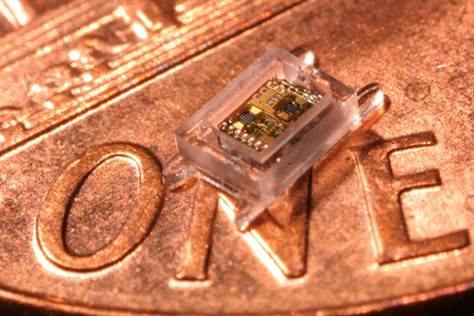

- Font:
- +
- -
Researchers recently unveiled the first complete millimeter-scale computing system that is about the size of the letter "N" on the back of a penny (or about the same size as the letter in this sentence).
This tiniest computer to date is a prototype of an implantable eye pressure monitor for glaucoma patients. Key to this unit linking up with other computers to form wireless sensor networks is a compact radio that needs no tuning to find the right frequency.
One day, these Lilliputian computers could track pollution, monitor structural integrity, perform surveillance, or make virtually any object smart and traceable.
Better, faster, smaller
Nearly invisible millimeter-scale systems could enable ubiquitous computing
by following the trajectory of Bell's Law, a corollary to Moore's Law.
(Moore's Law says that the number of transistors on an integrated
circuit doubles every two years, roughly doubling processing power.)
Bell's Law says a new class of smaller, cheaper computers comes along about every decade. With each new class, the volume shrinks by two orders of magnitude and the number of systems per person increases. The law has held from 1960s' mainframes through the '80s' personal computers, the '90s' notebooks and the new millennium's smartphones.
[Read also: 10 Revolutionary Computers]
"When you get smaller than hand-held devices, you turn to these monitoring devices," said David Blaauw, a professor of electrical engineering and computer science at the University of Michigan who is working on the new tiny computer.
"The next big challenge is to achieve millimeter-scale systems, which have a host of new applications for monitoring our bodies, our environment and our buildings."
Power at small scales
The new system is targeted toward medical applications,
focusing on a pressure monitor designed to be implanted in the eye to
conveniently and continuously track the progress of glaucoma, a
potentially blinding disease. (The device is expected to be commercially
available several years from now.)
In a package that's just over one cubic millimeter, the system fits an extremely low-power microprocessor, a pressure sensor, memory, a thin-film battery, a solar cell and a wireless radio with an antenna that can transmit data to an external reader device that would be held near the eye.
"This is the first true millimeter-scale complete computing system," said Dennis Sylvester, also a professor of electrical engineering and computer science at the University of Michigan.
The processor in the eye pressure monitor is the third generation of the researchers' Phoenix chip, which uses a unique architecture and an extreme sleep mode to achieve ultra-low power consumption.
The newest system wakes every 15 minutes to take measurements and consumes an average of 5.3 nanowatts. To keep the battery charged, it requires exposure to 10 hours of indoor light each day or 1.5 hours of sunlight. It can store up to a week's worth of information.
While this system is miniscule and complete, its radio doesn't equip it to talk to other devices like it. That's an important feature for any system targeted toward wireless sensor networks.
A compact radio
A step has been taken toward enabling such node-to-node
communication, courtesy of a consolidated radio with an on-chip antenna.
Researchers can precisely control the antenna's shape and size and
therefore how it can be used for communication.
[Read also: Tiny Radio Antennas Could Replace Building Wiring]
"This is the first integrated antenna that also serves as its own reference. The radio on our chip doesn't need external tuning," said David Wentzloff, an assistant professor of electrical engineering and computer science at the University of Michigan. "Once you deploy a network of these, they'll automatically align at the same frequency."
The scientists are now working on lowering the radio's power consumption so that it's compatible with millimeter-scale batteries.
Papers on these topics will be presented today (Feb. 22) at the International Solid-State Circuits Conference in San Francisco.
• Don't Sneeze: New Batteries Smaller than Salt Grains
• The Future: Incredible Shrinking Cities
• 10 Profound Innovations Ahead
© 2011 TechNewsDaily








“
Wow a tiny computer to monitor eye pressure! Guess it will replace marijuana in the treatment of glaucoma but I have just one question....
How do ya keep that little computer lit and how many fit into Zig Zap rolling papers?
”